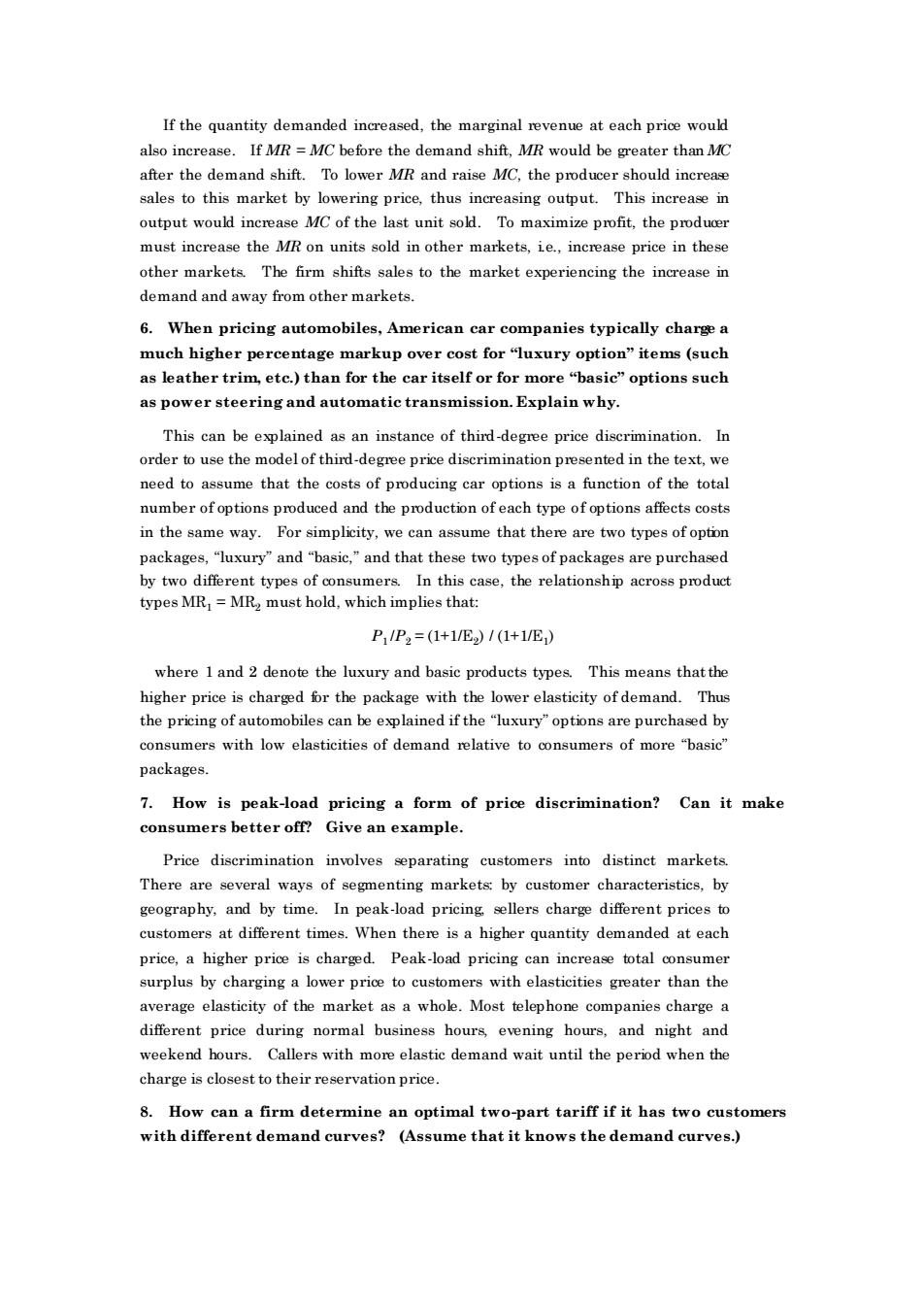正在加载图片...

If the quantity demanded increased.the marginal revenue at each price woul after the demand raise MC,the poducer sales to this market by lowering price,thus increasing output.This increase in output woul increase MC of the last unit sold.To maximize profit,the producer must increase the Mr on units sold in other markets.ie.increase price in these other markets The firm shifts sales to the market experiencing the increase in demand and away from other markets. 6.When pricing automobiles,American car companies typically charge much higher percentage markup over cost for"luxury option"items(such as leather trim,ete.)than for the car itself or for more "basic"options such as power steeringand automatic transmission.Explain why. This can be explained as an instance of third-degree price discrimination.In rdertouse the model of thrd-degreepriedisimnat n p need toasume that the of of th tota number of options produced and the production ofeach type of options affects costs in the same way.For simplicity,we can assume that there are two types of option packages,"luxury"and"basic,"and that these two types of packages are purchased by two different t s of consumers.In this case,the relationship acr oss pmoduct types MR=MR,must hold.which implies that: PR,=(1+1E)11+1E) where 1 and 2 denote the luxury and basic products types This means thatthe higher price is charged or the package with the lower elasticity of demand.Thus the pricing of automobiles can be explained if the"luxury"options are purchased by consumers with low elasticities of demand relative to consumers of more "basic' packages. 7.How is peak-load pricing a form of price discrimination?Can it make consumers better off?Give an example. Price discrimination involves eparating customers into distinct markets There are several ways of segmenting markets by customer characteristics,by geography.and by time.In peak-load pricing sellers charge different prices to customers at different times.When there is a higher quantity demanded at each :hy arging a lower price to。 with las ties grea ter than th average elasticity of the market as a whole.Most telephone companies charge a different price during normal business hours evening hours,and night and weekend hours.Callers with more elastic demand wait until the period when the charge is closest to their reservation price 8.How can a firm determine an optimal two-part tariff if it has two customers with different demand curves? (AS sume that it knows the demand curves.)If the quantity demanded increased, the marginal revenue at each price would also increase. If MR = MC before the demand shift, MR would be greater than MC after the demand shift. To lower MR and raise MC, the producer should increase sales to this market by lowering price, thus increasing output. This increase in output would increase MC of the last unit sold. To maximize profit, the producer must increase the MR on units sold in other markets, i.e., increase price in these other markets. The firm shifts sales to the market experiencing the increase in demand and away from other markets. 6. When pricing automobiles, American car companies typically charge a much higher percentage markup over cost for “luxury option” items (such as leather trim, etc.) than for the car itself or for more “basic” options such as power steering and automatic transmission. Explain why. This can be explained as an instance of third-degree price discrimination. In order to use the model of third-degree price discrimination presented in the text, we need to assume that the costs of producing car options is a function of the total number of options produced and the production of each type of options affects costs in the same way. For simplicity, we can assume that there are two types of option packages, “luxury” and “basic,” and that these two types of packages are purchased by two different types of consumers. In this case, the relationship across product types MR1 = MR2 must hold, which implies that: P1 /P2 = (1+1/E2 ) / (1+1/E1 ) where 1 and 2 denote the luxury and basic products types. This means that the higher price is charged for the package with the lower elasticity of demand. Thus the pricing of automobiles can be explained if the “luxury” options are purchased by consumers with low elasticities of demand relative to consumers of more “basic” packages. 7. How is peak-load pricing a form of price discrimination? Can it make consumers better off? Give an example. Price discrimination involves separating customers into distinct markets. There are several ways of segmenting markets: by customer characteristics, by geography, and by time. In peak-load pricing, sellers charge different prices to customers at different times. When there is a higher quantity demanded at each price, a higher price is charged. Peak-load pricing can increase total consumer surplus by charging a lower price to customers with elasticities greater than the average elasticity of the market as a whole. Most telephone companies charge a different price during normal business hours, evening hours, and night and weekend hours. Callers with more elastic demand wait until the period when the charge is closest to their reservation price. 8. How can a firm determine an optimal two-part tariff if it has two customers with different demand curves? (Assume that it knows the demand curves.)